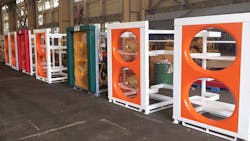Jet Precoolers help maintain freshness of imported berries
Public cold storage and logistics companies (3PLs) located near US border crossings or many years have helped to facilitate year-round availability of fresh produce for wholesalers, retailers, and consumers. Now a large number of them are using Jet Precoolers to recool imported berries.
In 2014, the US Department of Agriculture allowed fumigation to occur after arrival at US ports of entry. This has been a huge benefit to South American growers and exporters who are unable to fumigate in country of origin, allowing them to ship blueberries, blackberries, and other varieties to the United States that were not allowed previously.
USDA’s Animal and Plant Health Inspection Service (APHIS) requires treatment with methyl bromide, at 40° F for three hours. While this treatment eradicates the grapevine moth, it also jeopardizes fruit shelf life.
“Cooling to 32° F within two hours after fumigation can reduce decay by more than 1/3 after 10 days of storage,” said Jim Still, president of Global Cooling Inc, manufacturer of the Jet Ready Precooler. “Our Jets recool, too, which is every bit as important as initial precooling for highly sensitive fruit like berries. While some people still think that if you put warm product into a cold room, it will get cold, more and more operators and buyers realize that forced-air cooling is the only way to go, to maximize the shelf life that is remaining. In a 32° F room, our Jet Precoolers can recool berries to 33° or 34° F in one to two hours, as opposed to room cooling, which can take one to two days.”
Another detriment to room cooling: it can lead to “sweating” inside the packaging, as the innermost warmer berries and their high respiration rate emit warm air that condenses on other berries or the inside of the clamshell, whenever their temperature is colder than the dewpoint of that warm air.
“At 94% relative humidity,” said Still, “the dewpoint is only one or two degrees Fahrenheit colder.”
Botrytis, or gray mold, grows on fruit that has been damaged by too high temperature, and cooling the fruit rapidly to 32° F arrests the growth of the mold. Rhizopus, or soft rot, cannot grow below 40° F, and is another reason to recool with forced-air as quickly as possible.
When produce “breathes heavy,” because of temperature stress, it loses moisture. This loss of water weight, and also of carbon dioxide weight, is what shortens shelf life and reduces salable weight.
Prompt and thorough precooling, “and recooling, too,” Still said, are the most important steps in maintaining an effective cold chain. “Because once the vitality, in the form of weight loss and water loss, has occurred, you can’t put the water back in again,” he said.
For more information, see www.PreCoolers.net or call 1-610-248-9800.
